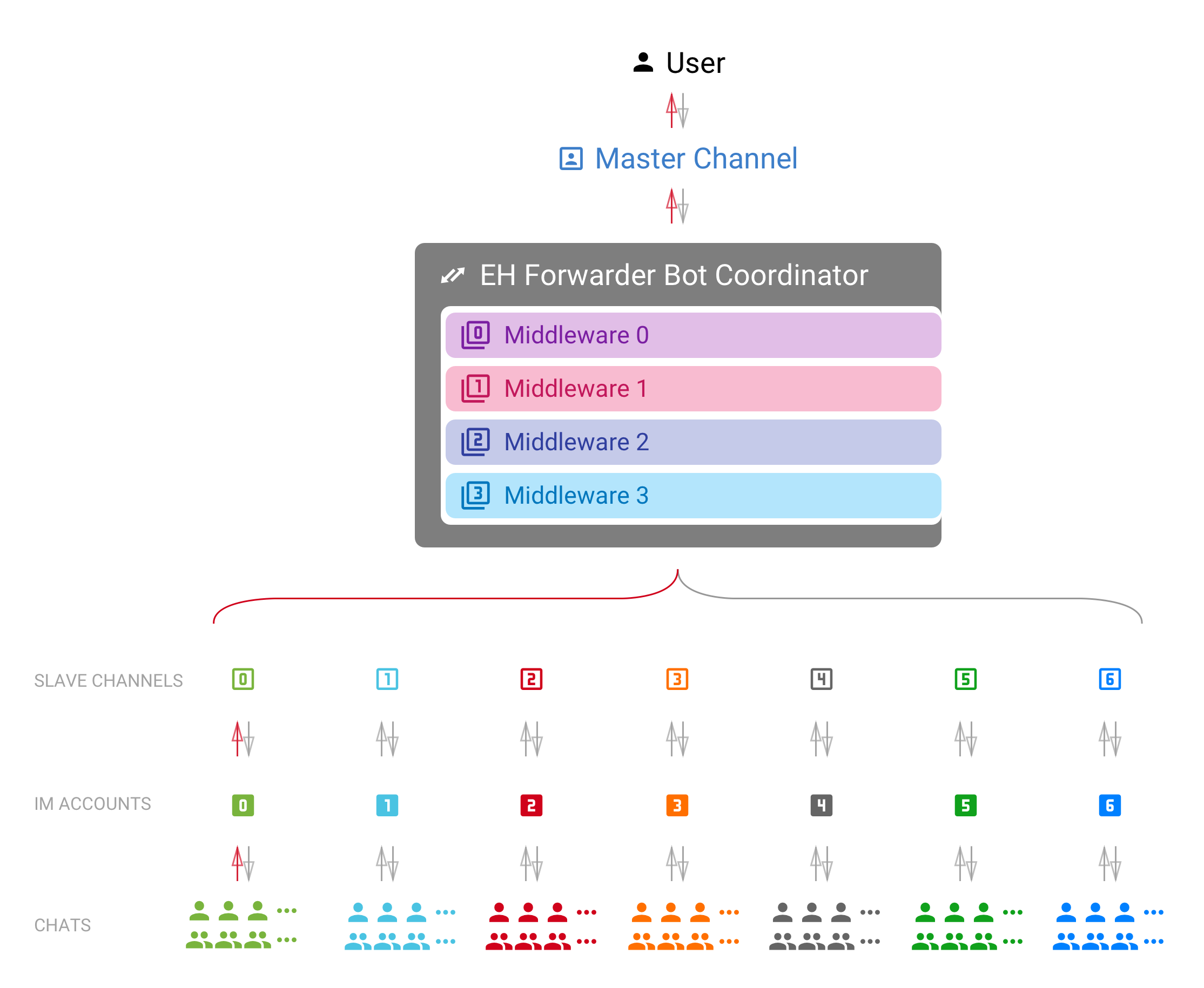Walk-through — EFB nasıl çalışır?¶
EH Forwarder Bot, kullanıcıların farklı sohbet platformlarındaki hesaplarını birleştirilmiş bir arayüzde kontrol etmesine ve yönetmesine olanak tanıyan genişletilebilir bir çerçevedir. 4 bölümden oluşur: Ana Kanal, bazı Bağımlı Kanalları, bazı Ara Katman Yazılımları ve bir Koordinatör.

- master channel¶
The channel that directly interact with the User. It is guaranteed to have one and only one master channel in an EFB session.
- slave channel¶
The channel that delivers messages to and from their relative platform. There is at lease one slave channel in an EFB session.
- coordinator¶
Kanal örneklerini koruyan ve kanallar arasında mesajlar gönderen bir yapı bileşeni.
- middleware¶
Kanallar arasında iletilen mesajları ve durumları işleyen ve gerektiğinde değişiklikler yapan modül.
Bilinecek kavramlar¶
- module¶
A common term that refers to both channels and middlewares.
- the User¶
- the User Themself¶
This term 1 can refer to the user of the current instance of EH Forwarder Bot, operating the master channel, and the account of an IM platform logged in by a slave channel.
- chat¶
A place where conversations happen, it can be either a private chat, a group chat, or a system chat.
- private chat¶
A conversation with a single person on the IM platform. Messages from a private conversation shall only has an author of the User Themself, the other person, or a “system member”.
For platforms that support bot or something similar, they would also be considered as a “user”, unless messages in such chat can be sent from any user other than the bot.
For chats that the User receive messages, but cannot send message to, it should also be considered as a private chat, only to raise an exception when messages was trying to send to the chat.
- group chat¶
A chat that involves more than two members. A group chat MUST provide a list of members that is involved in the conversation.
- system chat¶
A chat that is a part of the system. Usually used for chats that are either a part of the IM platform, the slave channel, or a middleware. Slave channels can use this chat type to send system message and notifications to the master channel.
- chat member¶
A participant of a chat. It can be the User Themself, another person or bot in the chat, or a virtual one created by the IM platform, the slave channel, or a middleware.
- message¶
Mesajlar tam olarak ana kanal ve bağımlı kanallar arasında iletilmektedir. Genellikle belirli bir türde bilgi taşırlar.
Her mesajın, en azından bağımlı kanala ait kendine özgü benzersiz bir kimliği olması gerekir. Düzenlenen herhangi bir mesaj aynı benzersiz kimlikle tanımlanabilmelidir.
- status¶
Bir mesaj biçimlendirilmemiş bilgi. Genellikle, sohbetlerin ve sohbet üyelerinin güncellenmesini ve mesajların kaldırılmasını içerir.
Bağımlı Kanallar¶
Bağımlı kanal işi nispeten basittir.
Ana kanala ve ana kanala mesaj gönderme.
Mevcut tüm sohbetlerin ve grup üyelerinin bir listesini korur.
Sohbetteki değişiklikleri izler ve ana kanala bildirir
Standart EFB Slave Kanal modeline uymayan özellikler Ek özellikler. olarak sunulabilir.
Ana Kanallar¶
Master channels is relatively more complicated and also more flexible. As it directly faces the User, its user interface should be user-friendly, or at least friendly to the targeted users.
Ana kanal işi şunları içerir:
Bağımlı kanallardan gelen mesajları alın, işleyin ve görüntüleyin.
Tüm bağımlı kanallardan gelen sohbetlerin tam listesini görüntüleyin.
Offer an interface for the User to use “extra functions” from slave channels.
Bağımlı kanallardaki güncellemeleri işle.
Mümkün olduğunda kullanıcı-dostu bir arayüz sağla.
Özel yazılımlar¶
Middlewares, kanallar arasında iletilen mesajları ve durumları izleyebilir, değiştirebilir veya geçersiz kılabilir. Middlewares, birbiri ardına, sırayla düzenlenir. Bir ara katman, varsa, önceki ara katman tarafından işlenen iletileri alacaktır. Bir katman, bir mesajı veya durumu geçersiz kıldığında, mesaj işlenmeyecektir ve daha fazla teslim edilmeyecektir.
Footnotes
- 1
“Themself” here is used as a derived form of a gender-neutral singular third-person pronoun.

